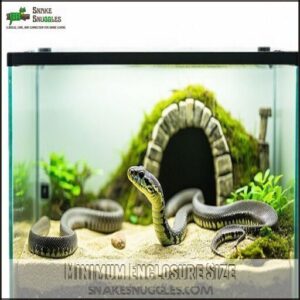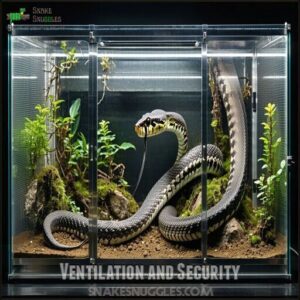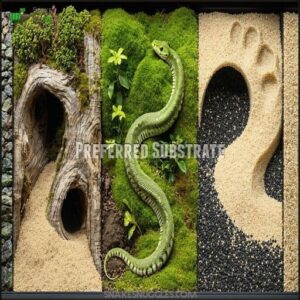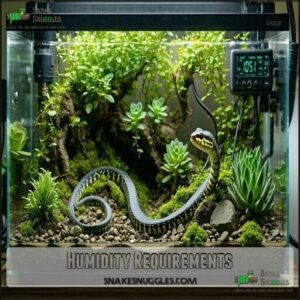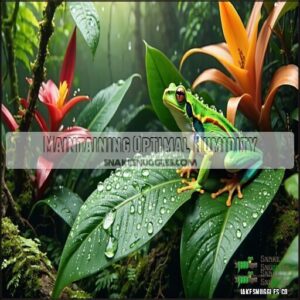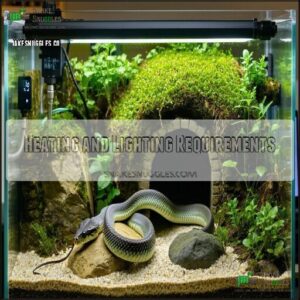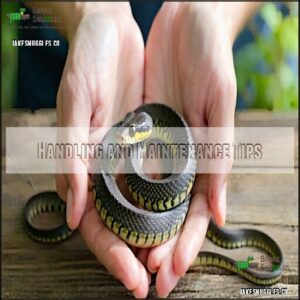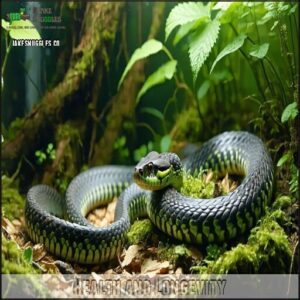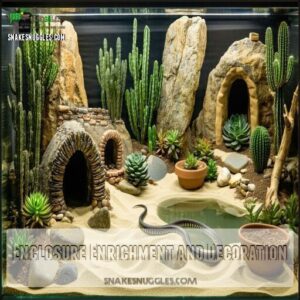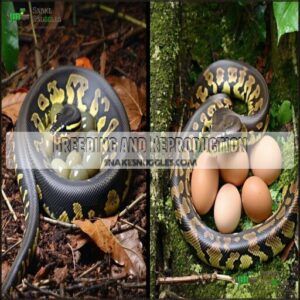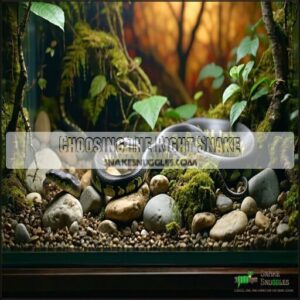This site is supported by our readers. We may earn a commission, at no cost to you, if you purchase through links.
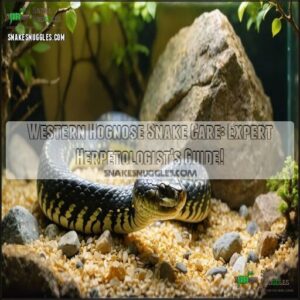 To care for a western hognose snake, you’ll need a spacious, escape-proof enclosure (at least 18x18x24 inches) with proper ventilation.
To care for a western hognose snake, you’ll need a spacious, escape-proof enclosure (at least 18x18x24 inches) with proper ventilation.
Keep a temperature gradient—90°F on the warm side for basking and 70°F on the cool side.
Use aspen bedding or a sandy-soil mix so they can burrow, and maintain humidity at 30-50%.
Feed them thawed, appropriately-sized mice every 5-7 days and provide fresh, clean water at all times.
These curious, playful snakes are known for their dramatic “playing dead” act, so don’t panic if yours pulls that trick!
Master these basics, and you’ll have a healthy, happy snake slithering about.
Table Of Contents
- Key Takeaways
- Western Hognose Snake Overview
- Housing and Enclosure Setup
- Substrate and Humidity Levels
- Heating and Lighting Requirements
- Feeding and Watering Requirements
- Handling and Maintenance Tips
- Health and Longevity
- Enclosure Enrichment and Decoration
- Breeding and Reproduction
- Choosing The Right Snake
- Frequently Asked Questions (FAQs)
- Is it legal to own a western hognose snake?
- What is the best bedding for western hognose snakes?
- Are western hognose snakes easy to take care of?
- What size tank does a western hognose snake need?
- How do you take care of a western hognose snake?
- What is the lifespan of a western hognose snake in captivity?
- Do western hognose snakes need UVB?
- How do I tell if my hognose snake is overweight or underweight?
- What signs indicate a stressed hognose snake?
- How do you safely clean their enclosure?
- Conclusion
Key Takeaways
- Provide a 20–40 gallon enclosure with good ventilation, a burrow-friendly substrate like aspen, and a temperature gradient of 90°F for basking and 70°F on the cool side.
- Maintain 30–50% humidity, avoid misting unless shedding, and keep water fresh and accessible at all times.
- Feed frozen/thawed mice every 5–7 days based on the snake’s size and wait 48 hours before handling after feeding.
- Watch for stress signs like constant hiding or hissing, and regularly clean the enclosure using reptile-safe disinfectants.
Western Hognose Snake Overview
If you’re looking to add a unique reptile companion to your collection, the Western Hognose Snake might just steal your heart with its quirky personality and dramatic defense mechanisms.
A Western Hognose Snake brings charm and drama, from playful antics to its signature "playing dead" trickery.
These small, non-venomous serpents are known for their upturned snouts, adorable dramatic "playing dead" behavior, and relatively manageable care requirements that make them an intriguing choice for reptile enthusiasts.
Scientific Name and Classification
When exploring Western Hognose Snakes, you’ll discover a fascinating creature scientifically known as Heterodon nasicus. These remarkable reptiles belong to an intriguing snake taxonomy that’ll make any herpetology enthusiast’s heart race.
Here’s what sets them apart in the snake classification universe:
- Members of the vast Colubridae family
- Classified as rear-fanged venomous species
- Representing the Heterodon genus
- Taxonomically documented by Baird & Girard in 1852
Their evolutionary history places them in a unique position within snake classification, blending mild venom with an impressive genetic lineage that continues to intrigue researchers and snake enthusiasts alike.
Geographic Distribution
Since the early explorations of North American herpetologists, western hognose snakes have captivated researchers with their remarkable adaptability.
These resilient reptiles stretch across a vast geographic landscape, from southern Canada to northern Mexico, inhabiting diverse ecosystems.
| Region | Characteristic Terrain |
|---|---|
| Southwest | Arid & sandy landscapes |
| Midwest | Prairie grasslands |
| Plains | Open, sparse vegetation |
Their native habitats span multiple states, mainly thriving in Arizona, New Mexico, Texas, and surrounding regions.
These prairie-dwelling serpents excel in semiarid terrain, strategically positioning themselves near water sources while mastering the art of desert survival.
Their range variation exhibits an impressive ecological flexibility that continues to intrigue herpetologist-approved research.
Physical Characteristics
Boasting a distinctive upturned snout, western hognose snakes charm reptile enthusiasts with their unique physical characteristics.
These chunky serpents showcase remarkable diversity:
- Lengths ranging from 15 to 33 inches
- Keeled scales offering exceptional camouflage
- Varied color morphs with 35-40 dark splotches
- Pronounced sexual dimorphism, with females growing larger
Their bulldozer-like build and pig-like nose make them truly unforgettable.
Housing and Enclosure Setup
When setting up a home for your Western Hognose Snake, you’ll want to prioritize a secure, spacious enclosure that mimics their natural habitat.
Your snake’s comfort depends on creating the right environment with proper size, substrate, and temperature zones that allow them to burrow, regulate their body heat, and feel safe.
Proper size, substrate and temperature zones allow them to burrow and regulate their body heat.
Minimum Enclosure Size
After learning about western hognose snake characteristics, let’s map out their perfect home sweet home!
Remember: size matters when creating a reptile paradise. Your snake needs room to roam, burrow, and feel secure.
| Snake Stage | Enclosure Size | Recommended Type | Depth Requirement | Notes |
|---|---|---|---|---|
| Hatchling | 5-10 gallons | Plastic Tub | 4+ inches | Cozy starter home |
| Juvenile | 10-20 gallons | PVC Enclosure | 6 inches | Growing space |
| Adult Male | 24" x 10" | Glass/Rack | 8 inches | Compact territory |
| Adult Female | 36" x 18" | Front-Opening PVC | 10 inches | Spacious setup |
| Breeding | 40-gallon | Bioactive | 12 inches | Maximum comfort |
Prioritize floor space over height – these ground-dwellers love exploring horizontal real estate!
Enclosure Type and Design
When selecting your Western Hognose snake enclosure, three primary materials shine: PVC, glass, and plastic tanks.
Front-opening PVC enclosures reign supreme, offering superior insulation and minimizing snake stress during handling. Their design provides excellent security and temperature regulation.
Consider a bioactive setup with carefully placed decorative rocks that are securely embedded.
Choose an enclosure that matches your snake’s size, prioritizing floor space and creating a comfortable habitat that mimics their natural environment while ensuring their safety and well-being.
A 48"x24"x24" enclosure is suitable for adults.
Ventilation and Security
When crafting a Western hognose snake habitat, your enclosure’s ventilation and security aren’t just details—they’re lifelines.
These little escape artists require a fortress-like setup that balances airflow with containment.
Your ventilation strategy should be precise and thoughtful:
- Prevent potential breakouts with vigilant lid checks
- Install mesh panels to maximize cross-ventilation
- Seal microscopic gaps using silicone door wraps
- Position vents strategically above substrate levels
- Create temperature gradients through careful airflow design
Quality screen tops are more than aesthetic accessories; they’re critical barriers protecting your snake.
Considering proper air circulation is fundamental for a healthy environment.
Double-check wire locks and clips weekly, ensuring no weak points exist.
Aim for mesh types that offer sound protection while maintaining prime air circulation.
Remember, a well-designed enclosure isn’t just about keeping your snake inside—it’s about creating a safe, breathable environment that mimics their natural habitat.
Your attention to ventilation and security demonstrates true reptile husbandry expertise.
Substrate and Humidity Levels
If you want your Western Hognose Snake to thrive, you’ll need to nail the substrate and humidity levels in its enclosure.
Your snake’s comfort depends on creating a habitat that mimics its natural desert-like environment, with a deep, loose substrate that allows for burrowing and a carefully maintained humidity range between 30-50%.
Preferred Substrate
After carefully setting up your Western Hognose snake’s habitat, choosing the right substrate becomes your next mission.
Aim for a 2-3" burrowing depth that’ll make your snake feel right at home.
Aspen bedding reigns supreme for reptile substrate enthusiasts, offering the perfect mix for digging and comfort. Coconut husk is also a great option for maintaining humidity.
Substrate Benefits Watching Out For
Skip cedar and pine – they’re bad news for your scaly friend!
Humidity Requirements
Maintaining the right humidity for your western hognose snake is like walking a tightrope—delicate but doable. These prairie dwellers thrive in a dry environment with humidity levels between 30-50%.
- Invest in a digital hygrometer for precise monitoring
- Position water bowls strategically to control moisture
- Assure excellent enclosure ventilation
- Skip misting unless preparing for shedding
- Watch for early signs of respiratory stress
A reliable hygrometer is essential for monitoring humidity levels.
Your substrate choice plays a pivotal role in humidity control.
Maintaining Optimal Humidity
Your Western hognose snake’s health hinges on humidity harmony.
After mastering basic substrate moisture, you’ll want to become a humidity hero.
A reliable hygrometer is your secret weapon—tracking those delicate 30-50% ranges like a pro.
Water bowls, strategic misting, and occasional fogging can help, but don’t go overboard.
A hognose hygrometer is an important tool for monitoring these conditions.
| Method | Effectiveness | Complexity | Frequency | Cost |
|---|---|---|---|---|
| Hygrometer | High | Low | Constant | Low |
| Manual Misting | Medium | Medium | Daily | Minimal |
| Water Evaporation | Low | Low | Weekly | Low |
| Fogging System | High | High | Occasional | Medium |
| Substrate Selection | High | Medium | Periodic | Variable |
Watch for shedding quality—your best humidity health indicator.
Heating and Lighting Requirements
If you want your Western Hognose Snake to thrive, you’ll need to master the art of creating the perfect thermal environment with precise heating and lighting.
Your snake’s health depends on maintaining a carefully designed temperature gradient and providing the right light cycle, so let’s break down the essentials of keeping your scaly friend comfortable and happy.
Temperature Gradient
Your western hognose snake craves a perfect temperature dance—think of it as their personal comfort zone safari!
Set up a cozy thermal runway: a toasty 90-95°F basking spot and a chill 70-75°F cool zone.
Strategic hides across temperature zones let your snake decide its ideal hangout.
This herpetologist-approved approach mimics their natural habitat, keeping your scaly friend happy and healthy.
Heating Methods
When setting up your hognose snake’s habitat, heating matters big time!
Here’s how to keep your scaly friend toasty:
- Use heat mats for ground warmth
- Install ceramic emitters for spot heating
- Add basking bulbs to create temperature gradients
- Always pair heating methods with a reliable thermostat
Your snake needs multiple heating options to mimic its natural environment, preventing cold spots and ensuring comfort throughout its terrarium.
Lighting Schedule
Your snake’s day-night rhythm depends on a carefully crafted lighting schedule.
Aim for 14-16 hours of light during spring and summer, adjusting to 8-10 hours in autumn.
Install a UVB bulb covering half the enclosure, mimicking natural diurnal rhythms.
This approach supports your western hognose snake’s health, reducing stress and promoting reptile lighting conditions.
Feeding and Watering Requirements
If you’re ready to become a Western Hognose Snake caretaker, you’ll need to master their unique feeding and hydration requirements.
Your snake’s diet and water intake are paramount for its health, so you’ll want to follow precise guidelines that guarantee your scaly friend stays happy and well-nourished.
Dietary Needs
Your hognose’s herpetology diet needs precision! These carnivorous cuties thrive on carefully selected meals that match their natural hunting instincts.
- Choose prey matching their head size
- Prioritize frozen/thawed rodents
- Vary diet for nutritional balance
Mice are menu staples, but don’t overfeed.
Garter snakes, for example, need varied protein sources like fish and insects.
Portion control keeps your scaly friend healthy and happy, preventing potential obesity while promoting peak nutrition.
Feeding Schedule
When caring for your western hognose, mastering the feeding schedule is paramount for their health.
Here’s your go-to guide:
- Match prey size to their head’s width
- Feed hatchlings pinky mice every 3-5 days
- Offer adults 2-3 rat fuzzies every 7-14 days
- Time meals during morning or evening hours
- Wait 48 hours before handling after feeding
Pro tip: Patience is key with these sometimes picky eaters!
Water Quality and Hydration
After nourishing your western hognose snake, it’s water time!
Choose a shallow, wide bowl that lets them drink easily and clean it every 2-3 days.
Fresh water prevents bacteria growth and supports overall reptile hydration.
Monitor water quality closely, watching for signs of dehydration like wrinkled skin or dull eyes.
A consistent water source keeps your scaly friend healthy and happy.
Handling and Maintenance Tips
When handling your Western Hognose Snake, you’ll want to use gentle, confident techniques that minimize stress and guarantee both your and the snake’s safety.
Always support the snake’s body fully, move slowly, and wash your hands before and after handling to maintain a healthy connection with your scaly companion.
Handling Techniques
Every skilled handler knows that mastering hognose handling techniques takes patience and a gentle touch.
Move slowly and deliberately to reduce stress, supporting the snake’s body without sudden movements.
Direct skin contact builds trust faster than gloves.
Learn to read your snake’s temperament, avoiding quick grabs that might trigger defensive behaviors.
Calm, consistent interactions are key to successful bonding.
Support and Restraint
The art of gentle support transforms snake handling from a potential ordeal into a smooth interaction.
Carefully cradle your Western hognose with two hands—one near the head, another mid-body—avoiding restrictive grips.
Use soft, steady movements to prevent stress and build trust.
If the snake becomes defensive, gently redirect its path using a flat object, ensuring both your safety and the snake’s comfort.
Hygiene and Cleaning
Keeping your snake’s enclosure clean is key to good reptile health!
Spot-clean daily for waste removal and change the substrate when it’s dirty.
Replace water frequently to maintain water sanitation and reduce bacteria.
Use a reptile-safe cleaner for weekly enclosure disinfection.
These preventative measures guarantee your hognose thrives in a spotless tank and stays happy, healthy, and stress-free.
Health and Longevity
Keeping your western hognose snake healthy isn’t hard if you stay on top of its care and watch for signs of illness.
With proper attention and a good setup, these snakes can live 15 to 20 years, giving you a decade or two of fascinating companionship.
Common Health Issues
Even with a good setup, hognose snakes can face health hiccups. Respiratory infections crop up when it’s too cold, while low humidity risks bad sheds.
Skin troubles like scale rot happen if their space’s dirty. Anorexia can point to stress or illness, so act quickly.
- Signs to watch for: Wheezing, swollen scales, regurgitation.
- Keep the enclosure clean.
- Set proper temps and humidity.
- Schedule regular veterinary checkups.
Lifespan and Aging
The hognose lifespan averages 12–20 years, offering decades of companionship when cared for correctly.
With age, you might notice slower movements or a dwindling appetite—common aging signs in reptiles.
For health and longevity, focus on geriatric care.
- Substrate: Use soft, burrow-friendly material for older snakes.
- Feeding: Offer smaller, easier-to-digest meals to aging hognoses.
- Hydration: Keep water fresh and easily accessible to avoid dehydration.
- Shedding: Older snakes may shed unevenly; mist gently if needed.
- Health Checks: Monitor for signs of illness, as lifetime factors can impact their maximum age.
Just like us, they deserve extra TLC in their golden years!
Veterinary Care
Your hognose snake deserves excellent veterinary care to avoid common health issues like respiratory infections, scale rot, or regurgitation problems.
Annual check-ups are part of herpetologist-approved care, ensuring early detection through tools like fecal exams.
If you notice wheezing, swelling, or loss of appetite, an expert in reptile care can provide anorexia treatment or preventative care.
Think of these visits as your snake’s insurance policy for a long, healthy slither!
Skipping them? That’s playing with fire.
Enclosure Enrichment and Decoration
Adding enrichment and decorations to your Western Hognose Snake’s enclosure isn’t just about making it look nice—it helps create a natural, stimulating environment.
With the right hides, climbing options, and textures, you’ll support their instincts and keep them active and curious.
Hides and Shelters
Snakes appreciate a cozy spot to relax, so offer several hides and shelters in your reptile enclosure. Mimic their natural snake habitat with a mix of secure hides like log shelters, clay caves, and leaf covers.
Always prioritize Hide Placement—scatter them across warm and cool zones.
Include at least three options:
- DIY Hides using boxes or cork bark.
- Burrow-friendly areas with four-inch-deep substrate.
- Pre-made rock caves for secure enclosure enrichment.
Multiple hides reduce stress, providing privacy and comfort for your western hognose snake.
Climbing Structures
Adding climbing structures to your Western Hognose’s setup isn’t a must, but they spark curiosity and enrichment.
Focus on safe, stable additions:
- Rocks: Guarantee rock stability to prevent accidents.
- Branches: Prioritize branch safety and easy cleaning.
- Logs: Create low-enclosure climbs with structural integrity.
- Decorative Walls: Boost sensory stimulation and enrichment value.
These small touches mimic nature, transforming your reptile enclosure into a stimulating, engaging environment!
Sensory Stimulation
Switch things up to keep your snake curious!
Add novel objects like reptile-safe rocks, leaf litter, or branches for tactile exploration.
Introduce textures for paws-off fun and use visual cues like varied patterns or colors to grab attention.
Want some creativity? Try subtle scent enrichment—rub safe smells on decor for intrigue.
A spiced-up enclosure reduces boredom, ensuring happy, stimulated snake pet living—and you’re mastering reptile care!
Breeding and Reproduction
Breeding Western Hognose Snakes is a fascinating process that requires careful preparation and attention to detail.
You’ll need to replicate their natural seasonal changes to encourage mating and guarantee healthy offspring.
Mating and Courtship
Breeding and reproduction begin in the spring breeding season when temperatures and light mimic nature. During mating and courtship, males charm females with chin rubs and tail vibrations—snake flirting at its finest!
Here are key points for successful hognose breeding:
- Confirm females are healthy and well-fed to handle clutch size demands.
- Observe gentle courtship rituals to avoid stress.
- Pair compatible snakes to boost genetic diversity.
- Monitor for successful attraction while keeping the enclosure calm.
Egg Incubation
Maintaining steady incubation temperature (78-84°F) and proper humidity control (70-80%) is key to hatching success.
Use perlite or vermiculite as reliable incubation mediums, and avoid turning the eggs.
Egg candling can help monitor development without disrupting them.
Patience is key—egg incubation typically lasts 50-65 days.
By nurturing conditions, you’ll soon welcome healthy hatchlings into the world.
Hatchling Care
Hatchling care starts small—literally! These tiny snakes thrive in compact spaces, easing stress and helping you track neonate health.
Keep a warm side at 85-90°F, a cool side at 70-75°F, and fresh water daily.
After egg incubation, feed pinky mice 5-7 days post-hatch.
- Use small enclosures.
- Guarantee proper temperature gradients.
- Monitor growth and shedding issues.
- Scent prey if needed.
Choosing The Right Snake
When choosing a Western Hognose Snake, it’s important to think about their temperament, availability, and fit for beginners.
These snakes are generally hardy, manageable, and full of personality, making them a popular choice for first-time owners.
Suitability for Beginners
Western hognose snakes are beginner-friendly snakes, offering ease of care in handling and enclosure simplicity.
While their picky feeding habits can frustrate new owners, patience solves it.
Their small size and calm snake temperament make them a great fit for beginners.
With an initial investment in a secure setup and guidance, they’re perfect if you’re ready to learn reptile ownership!
Personality and Temperament
Got patience? You’ll enjoy a western hognose snake’s unique personality and temperament.
These snakes are curious yet shy, sometimes showing dramatic defensive behaviors like hissing, neck flattening, or even playing dead—truly nature’s little performers!
Despite their bold antics, their docile nature shines through with regular, gentle handling.
Over time, they learn to associate you with safety, becoming calmer and more trusting in captivity. Pay close attention to snake behavior; their posture and movements often reveal mood shifts.
Each hognose shows individual variation in reactions—some more tolerant of handling than others.
With consistent care, they transform from drama kings and queens to surprisingly relaxed companions with minimal fuss!
Availability and Purchase
Finding a Western Hognose Snake is fairly simple but requires research.
For healthy, captive-bred snakes:
- Reptile stores with experienced staff.
- Breeder networks, focusing on reputable sellers.
- Online vendors with great reviews (MorphMarket’s a favorite).
- Snake auctions, though wild-caught snakes may sneak in.
- Legal restrictions, check local laws before buying.
Prices range widely, depending on morph availability.
It’s important to remember snake temperament before buying.
Think long-term care, not just cost, before making a purchase!
Frequently Asked Questions (FAQs)
Is it legal to own a western hognose snake?
Owning a western hognose snake is legal in many places, but it depends on your local laws.
Some areas require permits or ban exotic pets entirely, so check your state and city regulations before buying one.
What is the best bedding for western hognose snakes?
Choose aspen bedding or a bioactive mix for your western hognose snake.
It’s perfect for burrowing, easy to clean, and helps maintain low humidity.
Avoid cedar and pine—they’re toxic and can harm your snake.
Are western hognose snakes easy to take care of?
Caring for a western hognose snake might feel intimidating at first, but it’s easier than you’d think!
With the right setup—proper temps, substrate, and feeding—they’re low-maintenance, quirky, and perfect for reptile enthusiasts.
What size tank does a western hognose snake need?
Your western hognose snake needs at least a 24” x 18” x 18” tank, but larger females might need a 36” x 12” x 18” setup. Prioritize floor space, good ventilation, and burrowing depth.
How do you take care of a western hognose snake?
Happy hognose homes hinge on heat, habitat, and health!
Provide a cozy 20-40 gallon enclosure.
Keep temperatures 90°F basking to 75°F cool, maintain 30-50% humidity, and feed thawed rodents weekly.
They’re burrowers, so include deep substrate!
What is the lifespan of a western hognose snake in captivity?
In captivity, Western hognose snakes can live 15-20 years with proper care.
Keep their habitat cozy, feed them right, and monitor their health—these quirky little guys could stick around longer than your houseplants!
Do western hognose snakes need UVB?
UVB isn’t a must for western hognose snakes, but it’s a nice bonus.
It helps with vitamin D3 synthesis and overall health.
If you add it, use low-intensity UVB that mimics their natural habitat.
How do I tell if my hognose snake is overweight or underweight?
If your snake looks like it swallowed a sausage, it’s overweight!
Check its spine—it should feel slightly bumpy, not sharp (too skinny) or buried under fat (too chubby).
Healthy snakes have smooth, tapered bodies.
What signs indicate a stressed hognose snake?
If your hognose snake constantly hides, hisses repeatedly, refuses food, or strikes defensively, it’s probably stressed.
Watch for unusual burrowing or climbing and check enclosure conditions—too cold, too bright, or too crowded causes problems.
How do you safely clean their enclosure?
Start by moving your snake to a temporary, secure container.
Remove waste, replace substrate, and disinfect surfaces with reptile-safe cleaner.
Rinse well, dry completely, and reassemble decor.
Double-check temperatures and humidity before returning them.
Conclusion
Caring for a western hognose snake is like crafting the perfect recipe—every detail matters.
With the right enclosure, temperature gradient, and humidity, your snake will thrive.
Feed appropriately-sized mice, offer a burrow-friendly substrate, and always provide clean water.
Their quirky "playing dead" behavior adds charm, but don’t let it fool you!
By mastering these care basics, you’ll have a happy, healthy pet.
Use this western hognose snake care sheet approved by a herpetologist as your guide! Enclosure, temperature, and humidity.


